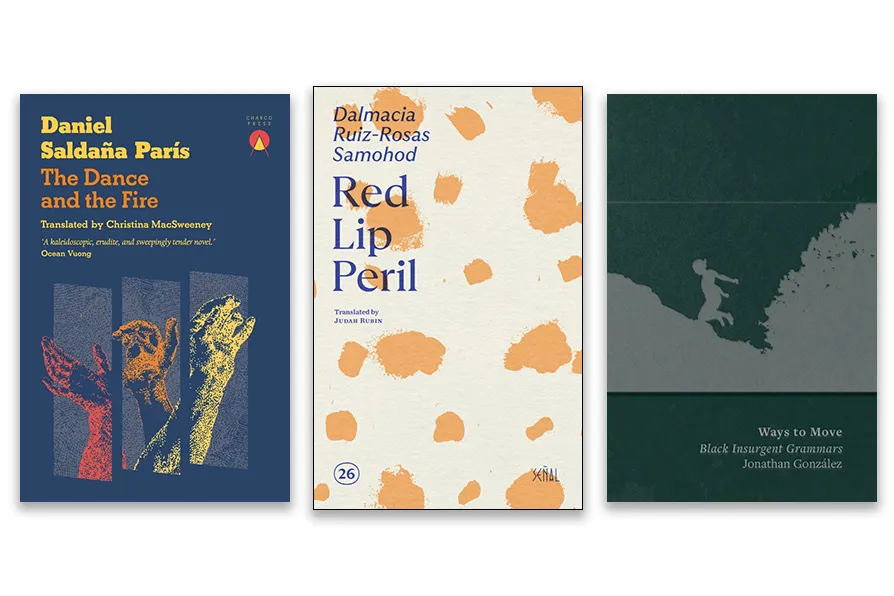MARIA DUARTE picks the best and worst of a crowded year of films
A mesmerising novel by Mexican Daniel Saldana Paris, and fierce poetry by Peruvian Dalmacia Ruiz-Rosas Samohod, and Jonathan Gonzalez


IN Daniel Saldana Paris’s The Dance and the Fire (Charco Press, £11.99), a series of wildfires threatens to engulf the city of Cuernavaca, Mexico — a place already doomed by dust, toxic fumes, and a mysterious outbreak.
The interwoven story, meticulously translated by Christina MacSweeney, unfolds through the voices of three friends who have known each other since secondary school: Natalia, a choreographer married to a much older and fading visual artist, Argoitia, taking notes for a new piece; Erre, a failed filmmaker who has returned from Mexico City to Cuernavaca after a divorce, enduring increasing physical and emotional pain; and Conejo, a recluse obsessed with conspiracy theories and cannabis, who stays in his bedroom caring for a blind father with an ignominious revolutionary past.
A choreography is in the making — inspired by German expressionist Mary Wigman, the medieval Danse Macabre, sexual awakenings, and the memories of a fragmented past that will soon turn to ashes.
This is a mesmerising novel of triangles: romantic, political, and environmental, where tensions pull at different angles and gradients. “Everything contains the seed of its own destruction,” warns Conejo, foreshadowing the growing sensation “that something is on the verge of collapse.”
MacSweeney’s translation beautifully conveys the sense of doom and impending disaster that permeates the book — a work conceived at the start of the Covid-19 pandemic, and one that speaks to our fractured world of broken human relationships, mediated by technology and shadowed by ecological collapse. A must-read.
Red Lip Peril by Peruvian poet Dalmacia Ruiz-Rosas Samohod (Ugly Duckling Presse, £10) contains only 11 poems, but each burns with such intensity and political force that you will wish for more from this outstanding voice of Lima. The pamphlet, deftly translated and accompanied by an illuminating note by Judah Rubin, includes a poem in which the poet sees:
“people running/ blocking roads stoning tanks/ AND YOU WEREN’T THERE/ in the fields in the factory/ but/ in the street/ agitating/ I SAW THE BLUE LIGHT’S GLARE/ the ambulance light/ the prowl cars red […] I DON’T KNOW IF YOU LOVE ME WANT ME MISS ME/ tortured/ in state detention/ I ONLY KNOW I SAW IT RAIN/ rocks sticks water from the police van/ I SAW PEOPLE RUNNING/ blocking roads stoning tanks/ AND YOU WEREN’T THERE/ you’re not around.”
These fierce, unforgettable poems trace Peru’s tumultuous years between 1978 and 1988 — from the massive protests against the military government of Francisco Morales Bermudez to the decade of internal conflict and the early years of neoliberal devastation. If you don’t yet know the work of Dalmacia Ruiz-Rosas Samohod, this book of rare political and emotional clarity is the place to begin.
Jonathan Gonzalez, an artist and scholar working at the intersections of racialisation, black geographies, creative practice, and diasporic literacies, brings an equally radical energy to Ways To Move Black Insurgent Grammars (Ugly Duckling Presse, £15).
Comprising eight texts that resist categorisation — part poetic investigation into black worlds and racial capitalism, part choreographic score, part journal and prose poem — this slim but dynamic book moves between 16th-century Obeah trials, Lee Perry’s Black Ark studio, the Caribbean, and 1930s New York. Among its many luminous passages, the opening poem, The Ways / Prologue, stands out:
“i want to be with you in the ways with you/ i want to be with you in the ways with you that wrestle under the castle of your skin/ i want to be with you in the ways with you that hack at the hold of freedom.”
A fascinating and fluid work — like an intricate dance, filled with gestures of survival and invention — Ways To Move expands the terrain of black poetics and political imagination.
Together, these three works — by Saldana Paris, Ruiz-Rosas Samohod, and Gonzalez — trace a constellation of resistance through art. Each, in its own register, turns movement into a form of political thought: the dance in the fire, the march in the street, the choreography of black survival. They remind us that creation and rebellion are not opposites but twins — that the body, whether trembling in desire, protest, or mourning, remains the last territory uncolonised by capital.
To read them side by side is to glimpse art’s stubborn capacity to imagine life otherwise: messy, collective, and defiantly alive amid the ruins.










